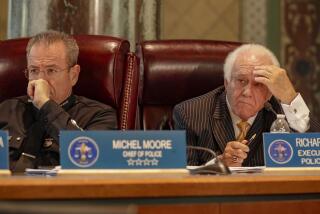Cities are trying to get the upper hand on illicit massage parlors
CATHEDRAL CITY, Calif. — — A man pulled up to a drab office building one recent afternoon, parking next to a row of scraggly shrubs. The only hint of color came from a small sign that looked like something made with a Lite-Brite. It said in red letters: “Massage.”
When he went inside and ordered a massage, an employee offered to perform a sex act for money. The man was a police officer, wearing a wire. Two women were arrested, and the site’s business license was revoked.
What happened after that was predictable and maddening, officials said: The next day, a man went to City Hall to apply for a business license — to open a massage parlor in the same space. There was no clear evidence that he was connected to the operation that had been raided the night before. The city had no legal reason to say no.
Across California, the number of illicit massage parlors has ballooned in recent years — the legacy, officials say, of a poorly crafted 2008 law. Back then, the massage industry was a mess, governed by a patchwork of local rules.
The California Massage Therapy Law was intended to professionalize the industry by creating a statewide certification program. But many officials say it impeded local control while inadvertently creating loopholes for shady businesses.
Now, Cathedral City Police Chief Kevin H. Conner said, the effort to contain illegal massage parlors is “like mowing the grass” — just when you think you’re done, you realize it’s already growing again, in the same place. That concern has been echoed in cities large and small, in Fresno and Fontana, San Mateo and San Francisco.
“The state was trying to make things better,” Conner said. “But we know the actual needs of the community.”
A movement is underway to replace the 2008 law with one that would maintain some statewide supervision while giving regulatory power to cities and counties and creating a mechanism for authorities to target business owners, not just employees.
The stakes are more significant than an increase in “happy endings,” as they are known in the illicit trade.
Some 5 million Californians receive massage therapy at clinics, at spas, from certified therapists, said Ahmos Netanel, chief executive of the nonprofit California Massage Therapy Council. Eighty percent of customers are women, and the vast majority of that treatment is legitimate. Everything else, Netanel said, “absolutely must be shut down.”
The 2008 law was intended to untangle some of the confusion in the industry.
Legitimate therapists who practiced in more than one community were often forced to pay for a license at each stop, for example. Legal, professional therapists often felt as if they were lumped in with sex workers, regulated in the same fashion.
So the state established the council, which would run a certification process for massage professionals. But the act had limited effect, in part because certification was voluntary.
Typically, certifications were given to legitimate practitioners but not business owners — including the unscrupulous ones who run illicit outfits, often employing trafficked Asian emigres who are forced to perform sex acts as a way to pay off their debts, authorities say.
The licensing essentially meant nothing to the illegal operations, where female employees were cycled through frequently and simply shipped to a new location if there was any heat from law enforcement.
“One night they’re here. The next night they’re in San Francisco, Los Angeles — wherever. They’re just running these people through,” said Stan Henry, Cathedral City’s former police chief and a member of the City Council.
Making matters worse, the statewide law complicated some local rules governing where and how many massage outfits could open.
Before the law, Cathedral City authorities felt they had some control. Massage professionals were licensed locally, identified and fingerprinted. Coachella Valley communities had reciprocal licensing agreements and shared information.
The law ended all of that, officials said, and local communities have struggled to regain momentum.
This spring, after Cathedral City raided two sites, Henry brought a proposal to the City Council that would have prohibited parlors from operating for one year at a location where authorities discovered criminal activity.
The proposal failed because of concerns that it would punish only landlords, not tenants who break the law.
Stumped, some local officials from around the state began lobbying to allow the troubled 2008 law to “sunset” at the end of the year. But the situation before the law’s passage was hardly ideal.
Legislators unveiled a compromise in April: the Massage Therapy Act of 2014. It would, among other things, ensure that local governments can regulate massage businesses using zoning ordinances.
It also would make it easier for local officials to hold business owners accountable for criminal activity. Often, the owners emerge unscathed from raids, while low-level female employees wind up in jail — women who have often been trafficking victims, authorities say.
“They are probably just as much victims as they are suspects,” Henry said. “It’s been very difficult to get to the people at the top.”
The measure is expected to come to a full vote in the Legislature by the end of August, said Assemblyman Jimmy Gomez (D-Echo Park), one of its sponsors.
“This is the return of land-use authority to cities and counties,” Gomez said.
At the former offices of one of the operations raided in Cathedral City, the door was locked on a recent day, and the “massage” sign was turned off.
But a menu still hung on the wall, offering massages from $40 to $98. And there was a new, hand-lettered sign: “Closed for temporary renovation.”
A neighbor, Ramiro Torres, 32, said he’d grown used to living down the street from the establishment. “A lot of cars come and go, but they don’t make it obvious,” Torres said as he washed his car. “We’re used to it.”
More to Read
Sign up for Essential California
The most important California stories and recommendations in your inbox every morning.
You may occasionally receive promotional content from the Los Angeles Times.







![[20060326 (LA/A20) -- STATING THE CASE: Marchers organized by unions, religious organizations and immigrants rights groups carry signs and chant in downtown L.A. "People are really upset that all the work they do, everything that they give to this nation, is ignored," said Angelica Salas of the Coalition of Humane Immigrant Rights. -- PHOTOGRAPHER: Photographs by Gina Ferazzi The Los Angeles Times] *** [Ferazzi, Gina -- - 109170.ME.0325.rights.12.GMF- Gina Ferazzi/Los Angeles Times - Thousands of protesters march to city hall in downtown Los Angeles Saturday, March 25, 2006. They are protesting against House-passed HR 4437, an anti-immigration bill that opponents say will criminalize millions of immigrant families and anyone who comes into contact with them.]](https://ca-times.brightspotcdn.com/dims4/default/34f403d/2147483647/strip/true/crop/1983x1322+109+0/resize/840x560!/quality/75/?url=https%3A%2F%2Fcalifornia-times-brightspot.s3.amazonaws.com%2Fzbk%2Fdamlat_images%2FLA%2FLA_PHOTO_ARCHIVE%2FSDOCS%2854%29%2Fkx3lslnc.JPG)



